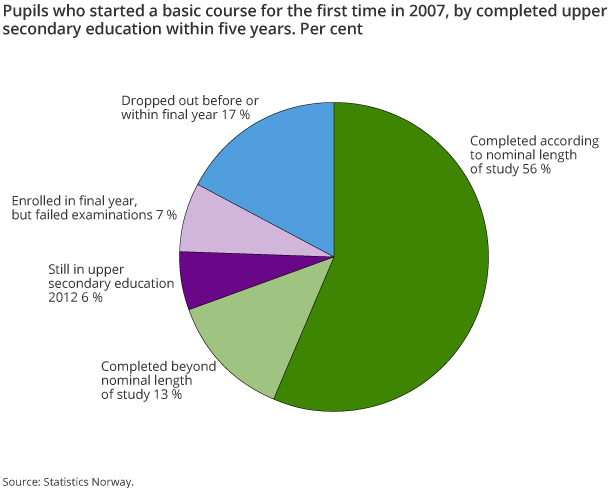Content
Published:
This is an archived release.
More immigrants complete upper secondary education
The figures for throughput in upper secondary education have been stable at 69 per cent in recent years. More immigrants are completing their upper secondary education. Pupils’ marks from lower secondary education together with parents’ level of education are two important factors for the throughput.
| 2007 | Change in percentage points | |||
|---|---|---|---|---|
| Started a basic course | Share of pupils who have completed upper secondary education within five years | 2006 - 2007 | 1994 - 2007 | |
| Total | 62 932 | 69 | -0.4 | 0.8 |
| Males | 32 376 | 64 | -0.7 | 3.3 |
| Females | 30 556 | 75 | 0.0 | -1.7 |
| General studies | 31 889 | 83 | -0.2 | 0.6 |
| Males | 14 420 | 78 | -0.7 | -1.1 |
| Females | 17 469 | 87 | 0.2 | 1.9 |
| Vocational studies | 31 043 | 55 | -0.2 | 4.5 |
| Males | 17 956 | 53 | -0.5 | 11.3 |
| Females | 13 087 | 58 | 0.1 | -4.5 |
Throughput in upper secondary education has remained relatively stable in the last decade. 68 per cent of pupils in the 1994 cohort achieved a general or vocational certificate within a five-year period, while the corresponding figure for the 1998 cohort is 72 per cent. For the 2002, 2004 and 2007 cohorts, 69 per cent completed upper secondary education within five years.
For immigrants, the throughput has increased by 3 percentage points, to 53 per cent. The share of immigrants dropping out of upper secondary school in the 2007 cohort fell by 5 percentage points from the 2006 cohort.
Seven out of ten of the 63 000 pupils who started in upper secondary school in 2007 achieved a university admission certification or professional competence within five years. Half of the pupils achieved a general certification, 20 per cent achieved a vocational certificate, and 30 per cent did not achieve any formal qualifications.
Differences among the different education programmes
83 per cent of the 32 000 pupils that started on general studies had completed within five years. The other 32 000 pupils started vocational studies, and of these 30 per cent achieved a vocational certificate, 25 per cent achieved a general certificate, and 45 per cent did not achieve any formal qualifications within five years.
Social background and gender are important factors
As in previous years, social background has a large impact on the pupils’ likelihood of achieving a certificate. The percentage of pupils that completes upper secondary education within the five-year period is larger for girls than boys, with 75 and 64 per cent respectively. A higher proportion of girls complete upper secondary education compared with boys in all groups of parents’ level of education.
As expected, the throughput increases when the level of parents’ education is high. 90 per cent have completed within five years when the parents have a long tertiary education, while the corresponding figure is 65 per cent when the parents’ highest education level is upper secondary school.
Pupils with high marks are more likely to complete upper secondary education than pupils with lower marks. 97 per cent of pupils with at least 50 lower secondary school points finished upper secondary education within five years, compared with 12 per cent of pupils who had achieved fewer than 25 points.
Regional differences
Oslo and Sogn and Fjordane were the counties with the highest throughput, with 75 per cent of pupils completing within five years. Akershus, Møre and Romsdal, and Rogaland are just behind with 74, 72, and 72 per cent respectively. The three northernmost counties together with Østfold had the lowest throughput, ranging from 49 to 65 per cent.
Direct transition gives lower drop-out rate
The drop-out rate is distinctly lower among pupils with a direct transition from lower to upper secondary education. 7 per cent of pupils who start a basic course in general education when they are 16 years old drop out of upper secondary education. In contrast, 43 per cent of pupils who start at the age of 17 or older drop out. For all pupils in the 2007 cohort, in both general and vocational education, the drop-out rate is 17 per cent.
Additional information
Statistics follow an intake of pupils through a five-year period in upper secondary education.

